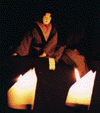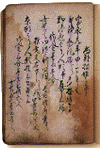Imada Puppet company [History]

The beginning of Imada Puppet dates back to the mid-Edo era in 1704 (first year of Hoei). There is a tradition of Kuroda Puppet dating back to 1688-1703 (Genroku era) but if you look at puppet companies with a clear origin date, you can say that Imada Puppet is the oldest of the Ina valley.
In 2003 (Heisei 15) we reached 300 years of existence. During this time there were ups and downs but we were continuously supported by puppet enthusiasts.
|
Year |
Era |
Event |
|---|---|---|
| 1704 | (Hoei 1) |
Beginning of Imada Puppet. Money was gathered all around the village to buy puppets, etc. to make the local shrine annual festival livelier, and the dedication to puppet show began. It was still a one-person puppeteer era. (the year after Chikamatsu Monzaemon’s play, "The Love Suicides at Sonezaki"(Sonezaki Shinju), gained great popularity at the Takemoto Puppet Theater in Osaka) |
| 1826 | (Bunsei 9) |
Around this time, choreographers, shamisen players, puppet makers, etc. were called from outside to the local shrine festival which was dedicated to puppeteer. |
| 1839 | (Tenpo 10) |
Around this time, Imada village was enjoying manipulating puppets all day in the village during the local shrine regular festival at Hachiman Daijinguu on March 15th, Suwa Daimyoujin on July 27th, Ise Daijinguu on August 15th. At this time, it was reported to the city hall that teachers, etc. were not called from outside. |
| 1844 | (Tenpo 15) |
|
| 1877 | (Meiji 20) | 
Until around this time, they traveled actively to perform in other villages. |
| 1888 | (Meiji 21) |
Around this time,the local shrine annual festival on March 15th was dedicated to puppeteer but, this year they bought a complete set from other villages starting by 57 puppet heads (kashira), costumes, props, etc. and a new troop was formed. |
| 1897 | (Meiji 30) |
The puppet stage was demolished during the renovation of the local Oomiya Hachiman shrine. |
| 1916 | (Taisho 5) |
Tenguya Hisakichi from Awa province repaint the old kashiras as he was asked. |
| 1944 | (Showa 19) |
Around the second world war it came down to a troop of only 4 ancients, 1 tayu and 3 puppeteers. |
| 1950 | (Showa 25) |
From this time, the company members, with the surviving tradition inherited from the 4 ancients, traveled to do performances and perform in village’s entertainment festivals. |
| 1952 | (Showa 27 ) |
Imada Puppet was rebuilt as the Puppet Department of the Community Center. This year after the war the local shrine Oomiya Hachimansha annual festival dedicated to puppets was recorded from October (from the following year 28, spring April and autumn October) |
| 1955 | (Showa 30) |
The Ina Puppet Preservation Council was formed by Imada, Kuroda and Waseda Puppet. |
| 1956 | (Showa 31) |
The first "Ina Puppet Preservation Council joint presentation" was held. As a new challenge "Twilight Crane" (Yuuzuru) was performed in October. Young people joined. |
| 1967 | (Showa 42) |
In November, a grand performance commemorating the elevation of the local Oomiya Hachimangu shrine was held. |
| 1973 | (Showa 48) |
From this time, the local shrine annual festival dedicated to puppeteer became the October annual Autumn festival. |
| 1975 | (Showa 50) |
In December, the Imada Puppet Preservation Council was also selected by the Agency for Cultural Affairs among the Ina valley puppet troops (Imada, Kuroda, Waseda) as "intangible folk cultural assets for which creation of record measures should be taken". |
| 1976 | (Showa 51) |
Inauguration of the Imada Puppet Preservation Council. |
| 1978 | (Showa 53) | 
Inauguration of the Imada Puppet Club at the Ryukyo junior high school. Directed by the Imada Puppet Company. |
| 1979 | (Showa 54) |
From this year, the preservation council activities were donations and gathering subsidies. Kashira reparations and paint touch-ups were entrusted to Ooe Minosuke from Tokushima. The council also renewed the costumes and these new costumes were shown off at the October annual Autumn festival. |
| 1980 | (Showa 55) |
From this year, a mentor from Awaji Puppet company was called to start seminars. The completed kashira paint touch-ups were shown off on the 15th October annual Autumn festival. |
| 1982 | (Showa 57) |
For the Iida Puppet Theater Carnival, Imada made their first cooperative work, the "Ina valley puppet kashira exposition", at Iida city art museum (down Tenryu, Benten harbour). As well as a three troops performance by Imada, Kuroda and Waseda to which puppeteers were invited. |
| 1983 | (Showa 58) |
On August 6th, the Imada Puppet troop performed its first new work also easy to understand for children, "Kotaro’s Tale" (Kotaro Monogatari), at the Iida Puppet Theater Carnival’s opening ceremony. This led to an increase of interest in the Iida Puppet Theater Carnival and Imada Puppet. In November, the local elementary school Tatsue asked for "Kotaro’s Tale" (Kotaro Monogatari) to be performed during school’s free time. It brought a lot of emotions to elementary students who met with Imada puppets for the first time. Later during a tour of Iida’s elementary schools, the city’s students had time to meet with Imada Puppet. In October, during the local junior high school Ryukyo culture festival, "Ryukyo festival" , Imada Puppet performed "Kotaro’s Tale" (Kotaro Monogatari) in front of 100 people of the 5 clubs choir, drama theater, art and production. It brought tears to the mothers of the audience. In November, the 4 troops made a joint presentation for the Ina Puppet show opening. It was the first 4 troops session. Hereafter, we did the opening every year. |
| 1984 | (Showa 59) |
The Ina Puppet Show Preservation Council was inaugurated for the 4 puppet companies Imada, Kuroda, Waseda and Furuta. From this year, mentors were invited to host joint seminars of gidayu, shamisen, later manipulation, every year for the 4 troops. This year, the annual number of performances of Imada Puppet suddenly went up to 20 times. In the following years, the number of performances recorded went from the previous 20 to 30 times. |
| 1988 | (Showa 63) | 
On August 6th, we performed at the Iida Puppet Theater Carnival "World Puppet Theater festival" for the opening of the new completed theater, the Iida Puppet Theater Hall. We performed only to the lights of Japanese candles, to "see the show in the lights of edo", "Oshichi’s Burning Love, Act Oshichi’s Fire Tower" (Date Musume Koi no Higanoko Oshichi hinomiyagura no dan) and "A Tragedy of Tokushima, Act of the Pilgrim Song" (Keisei Awa no Naruto Junrei Uta no dan). It got a great response from the overflowingly packed wealthy international audience. |
| 1991 | (Heisei 3) | 
In June, we performed "The Miracle at Tsubosaka temple" (Tsubosaka reigenki) at the Shimosuwa cultural center with the living national treasure tayuu living in Takemoto, Uruzawa Enza. In September, all of the 20 members of the troop including juniors participated in the World Puppet Festival thanks to Charleville-Mezieres’s invitation from France. Each one of the 2 performances brought more than 600 peoples, it made an impression on both professional puppeteers from every country’s and citizens, it achieved a big success. |
| 1992 | (Heisei 4) |
Re‐inauguration of the Imada Puppet Preservation Council. |
| 1994 | (Heisei 6) |
March, performance at the National Bunraku Theater of Osaka (hometown puppet show) |
|
"Sugawara and the Secrets of Calligraphy" (Sugawara Denju Tenarai Kagami) |
||
|
April, Imada Puppet Hall completed |
||
|
Tsuruzawa Seishirou from Tatsue became a professional bunraku shamisen player |
||
|
October "The Disputed Succession of the Date Family" (Meiboku Sendai Hagi) was performed for the 1st time in 10 years |
||
| 1998 | (Heisei 10) |
Performed in February at the Nagano Winter Olympics IOC opening ceremony |
| 2003 | (Heisei 15) | 
300th year of existence of Imada Puppet. Commemorative ceremonies and projects were held in September. At this time, the play "Shank’s Mare" (Tokaidochuu Hizakurige) which has not been played since Showa year 29 (1954) was performed. The laughs and applause of the audience were overflowing in the temple grounds. |
| 2004 | (Heisei 16) | 
Performance overseas in July at the "2004 Yunlin International Puppet Theater festival" in Taiwan’s Yunlin county. The 12 company members performed "The Ceremonial Sanbaso Dance" (Kotobuki Shiki Sanbaso) and "A Tragedy of Tokushima" (Keisei Awa no Naruto). A commemorative booklet, "Imada Puppet", was published for the 300 years of existence of Imada Puppet. |
| 2005 | (Heisei 17) |
From this year, beginning of the puppet seminars for American university students. |
| 2007 | (Heisei 19) |
In February, performed Taiwan’s overseas performance (Iida city Taiwan challenge), "The Ceremonial Sanbaso Dance" (Kotobuki Shiki Sanbaso) and "A Tragedy of Tokushima"(Keisei Awa no Naruto) In September, course at the Missouri University, America, Chicago. |
| 2008 | (Heisei 20) |
April, exposition room of the Imada Puppet hall completed |
|
August, main ceremony of the World Puppet Theater Festival |
||
|
"Kotaro’s Tale" (Kotaro Monogatari) performed after 25 years |
||
|
October, presentation of a new play "Ebisu dance" (Ebisu-mai) |
※A tayu is a reciter and singer in Bunraku puppet plays
※A kashira is from the head to the neck of the puppet including its head movement mechanism
※Gidayu is a school of Joruri with a strong narrative aspect that developed with bunraku (traditional Japanese puppet theater)

 Around this time, they gained a great popularity as they were asked to travel to perform in other villages.
Around this time, they gained a great popularity as they were asked to travel to perform in other villages.

